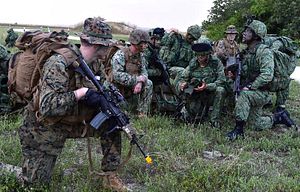On September 23, Singapore and the United States concluded a military exercise codenamed Valiant Mark.
Valiant Mark is an annual bilateral exercise held between the U.S. Marine Corps (USMC) and the Singapore Armed Forces (SAF). According to a statement by the USMC, the exercise is meant to enhance U.S. and Singaporean forces’ combined combat readiness through live fire and urban terrain training as well as amphibious operations familiarization. Building relationships and exchanging tactics allows both militaries to prepare for future joint combat operations and ensure smoother collaboration to accomplish missions.
Last year, Valiant Mark 14.1 was held in January 2014 in Singapore while Valiant Mark 14.2 was held in the United States in Camp Pendleton in December. According to the U.S. Department of Defense, Valiant Mark 14.2 featured the demonstration of three non-lethal weapons systems. These included the Active Denial System – a weapon that uses millimeter wave technology to produce an almost intolerable heating sensation – along with the Mini Distributed Sound and Light Array System and the Persistent Ground Surveillance System.
This year’s exercise, which took place from 7 to 23 September, included a series of live-fire exercises and professional sharing on weapons systems. About 200 personnel from the 7th Singapore Infantry Brigade and the 2nd Battalion, 4th Marine Regiment took part in the exercise. The highlight was a battalion amphibious operation, where troops from the SAF and USMC demonstrated their ship-to-shore capabilities.
Commanding Officer of the SAF’s exercise troops Lieutenant Colonel Fan Mun Poh and Executive Officer of the USMC’s exercise troops Major Samuel Cunningham, co-officiated at the closing ceremony at Jurong Camp this morning to mark the end of the exercise.
“Singapore and the US share excellent and long-standing bilateral defense relations,” a statement from Singapore’s Ministry of Defense (MINDEF) read.
“The two militaries interact extensively through bilateral and multilateral exercises, professional exchanges and the cross-attendance of courses. These regular interactions have enhanced the interoperability between the two armed forces and help foster mutual understanding among their personnel,” it added.
































